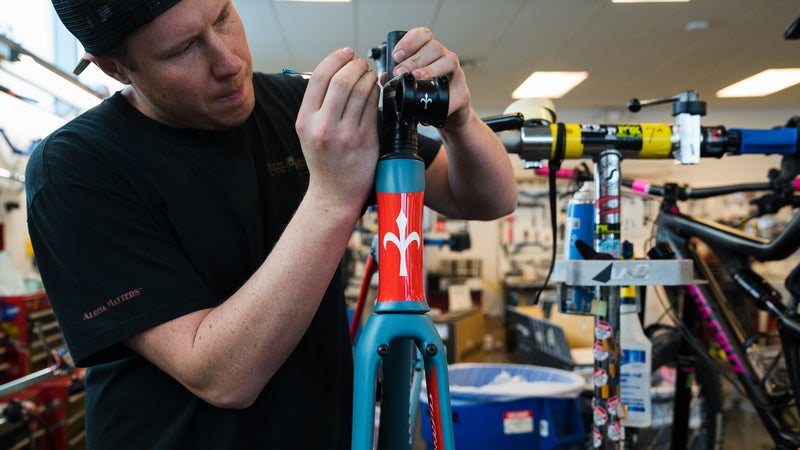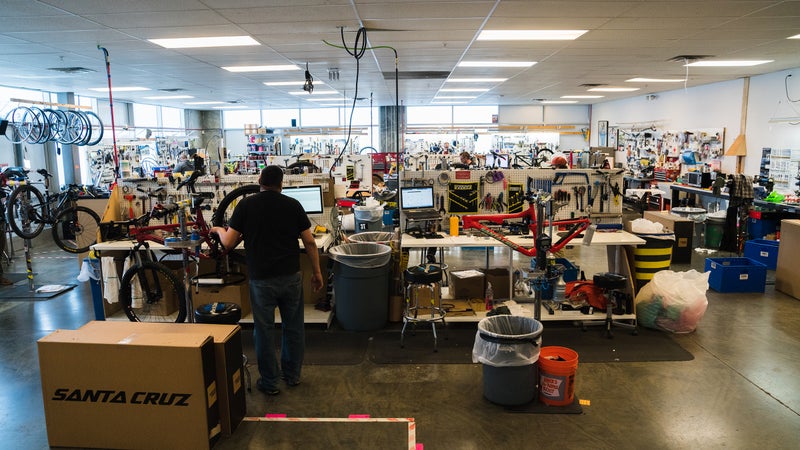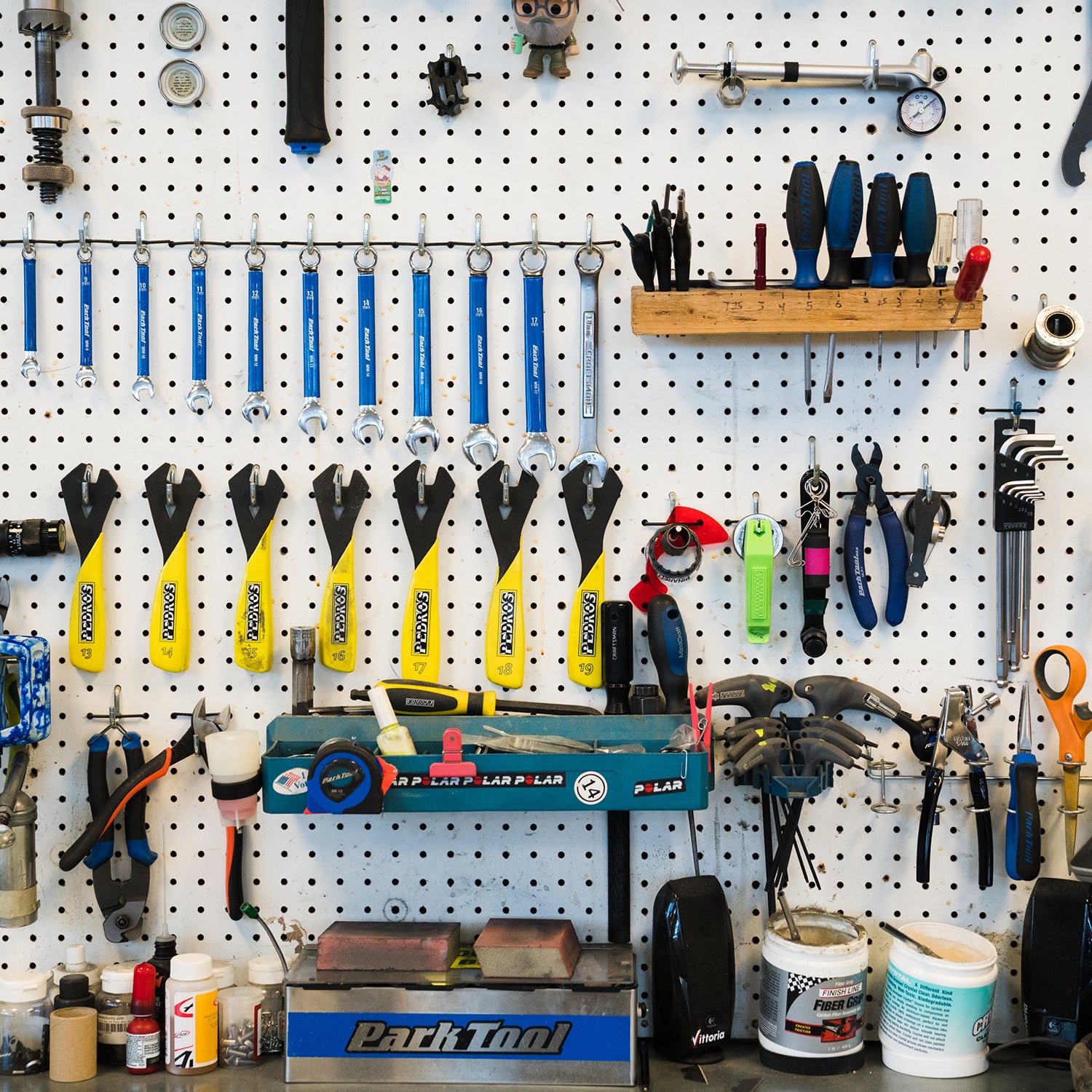’s sole brick-and-mortar storefront, a garage-size space inside parent company ’s diminutive Salt Lake City outdoor store, is stocked with only a dozen bikes and a few meager racks of helmets and apparel. Situated in an industrial district near the airport, the shop has concrete floors and wood and steel finishes that give it the feeling of an REI, though the entire store is smaller than a single department in one of those big-box retailers. At the center sit six flat-screen computer terminals, where customers can order not only from the small selection of items in the storefront but from the company’s entire inventory of 800,000 items housed in a warehouse bigger than three football fields. This small shop is a front to one of the country’s largest bike e-commerce platforms. But despite its lack of brick-and-mortar space, Competitive wants to be your local bike shop, no matter where you live.
Competitive didn’t always have such grand ambitions. In 1999, when Craig Zediker and two friends, Brendan Quirk and Tony Karklins, founded an 1,100-square-foot shop called Chainwheel in Little Rock, Arkensas stocking Cannondale, Trek, and Specialized, e-commerce hardly even existed. “We were avid cyclists living in a place where it was difficult to get the latest bike gear,” says Zediker. “We wanted to serve the local community.”
But when Zediker and Quirk, who bought out Karklins early on, began an online side project to resell classic Campagnolo components, and the venture started yielding real revenue, the pair’s eyes opened to the potential. “We realized, ‘Hey, maybe this internet thing isn’t a fad after all,’” remembers Zediker.

In 2000 they launched Bikeseller.com, which would eventually morph into CompetitiveCyclist.com, as a complement to their brick-and-mortar business. At first, “It was a lot of smoke and mirrors,” Zediker says. “We’d get orders on the site and then get online that night and order those items from QBP [the country’s biggest bicycle-equipment distributor].” There was no inventory system, no SKUs.
“I remember calling each other at night trying to keep up with it. It was like, ‘I think that’s the last red Castelli jersey we have, but I’m going to have to check the shelves,’” says Hap Seliga, who came on board in 2003 to help grow the mountain-bike side of the business. “It was the Wild West. There was no e-commerce expertise at the time, at Competitive but also on the internet in general. Everyone was just trying to figure it out.”
As online shopping became more widely accepted, Competitive Cyclist grew quickly, expanding to larger facilities in Little Rock twice and eventually employing a full-time staff there of 63. The company’s big break came in 2011, when e-tailer offered to purchase it. Zediker, Quirk, and Seliga, along with over half the Arkansas team, moved to Salt Lake City to join the much bigger parent company, which today employs more than 1,000 people.
Now Competitive is almost unrecognizable from those early days of scrambling for inventory. On the colossal warehouse floor, cycling merchandise is stacked among Backcountry’s own on three-story-tall shelves. Pickers with scan guns walk the aisles to collect and box orders, though there is also a pair of new Perfect Pick units, two-story, Death Star–looking machines the size of apartment blocks where robots package orders automatically. Then there’s an automated boxing station that scans and weighs small to midsize orders and builds custom boxes around them. The factory typically ships between 40,000 and 50,000 orders daily, with an all-time record of 64,174 packages on November 26, 2012. Competitive accounts for around 15 percent of Backcountry’s total business.
Selling small items like soft goods and apparel is a fairly easy proposition that many sites (like Backcountry.com) do well, but it’s the complete bike offerings that set Competitive apart. While a few other sites—Fanatik, RNA Cycles, Above Category—also sell bikes, Competitive, which ships over 10,000 bikes annually, has perfected the custom side of it as well as sheer volume. The company offers three purchasing models for any of its of bikes: preconfigured bikes from the manufacturer; package bikes featuring parts and builds unique to Competitive; and fully customized builds, for which there is no additional fee. And while customers can order online, most complete bike sales are facilitated by Competitive’s Gearheads, sales experts who help customers choose the right bike and size and, if they choose, customize their ride.

Once an order is placed, all the parts are pulled using the same system as the rest of the Backcountry inventory, then put together by an on-site mechanic. For a custom build, a mechanic receives frame, suspension, components, cockpit parts, and all the other bits and pieces as a stack of separate boxes. The 50-by-30-foot build room looks like a typical bike-shop work area—just bigger—featuring 18 workstations, each with its own bike stand and tools, and two additional boxing stations. Once a bike is built, it’s independently double-checked, given a test ride around the floor, and then packaged for shipping. Competitive strives to build and ship all bikes within 24 to 48 hours from the time the order is finalized, and overnight service is available for an additional charge. Customers have to do little assembly once they receive their bikes, usually just straightening the stem, positioning and tightening handlebars, and screwing on pedals.
Much has been written in recent years about the decreasing number of cyclists and the . And while it’s easy to blame online retailers for stealing business from brick-and-mortar stores, sees itself as a remedy for the problem, not the cause of it. “We’ve always believed that no matter where you live, you should be able to have a professional bike-shop experience,” Zediker says. By plumping up the online transaction with knowledgeable Gearheads, the company is trying to bring the expertise, friendliness, and service of an independent bike shop to the online marketplace.
“A lot of business models have gone the way of the dodo bird because of the internet,” says Zediker, who now runs the bike-assembly part of the business. “I’m a bike guy. I don’t want bike shops to go that route.” Indeed he looks like any aging bike racer and mechanic, with a muss of graying hair and a Day of the Dead sleeve tattoo covering an arm chiseled from a lifetime wrenching bikes. “But,” he says, “we have to change to keep up with the times.”
The truth is, with the increasing complexity of bikes and the rise of proprietary parts and standards, it’s tough for a local bike shop to stock enough bikes and parts to serve every customer the way a larger, online retailer can. Zediker instead sees the future of brick and mortar as lying with shops that can provide a great experience that stretches beyond retail sales—which, incidentally, is what Competitive is striving to do online—as well as with service. He calls out mobile shops such as and as refreshing new approaches.
Some of that change is already coming, with an increasing number of exclusively consumer-direct bike companies, like Canyon, YT Industries, Allied, and Eminent. (Karklins, who was partners with Zediker and Quirk back before Competitive, went on to found Allied Cycles.) Most other major bike brands are now formulating online sales schemes too.
In some ways, though, the bike industry is playing catch-up with broader . Already, eight in ten Americans shop online and 30 percent of shoppers say they purchase something by computer or phone at least once a week. “There is a generation now that has been buying everything online all of their lives,” Zediker says. “I think consumers are no longer afraid to buy $10,000 items on the internet.”
The question now is whether the company can continue to win over cyclists to its vision for the future.


